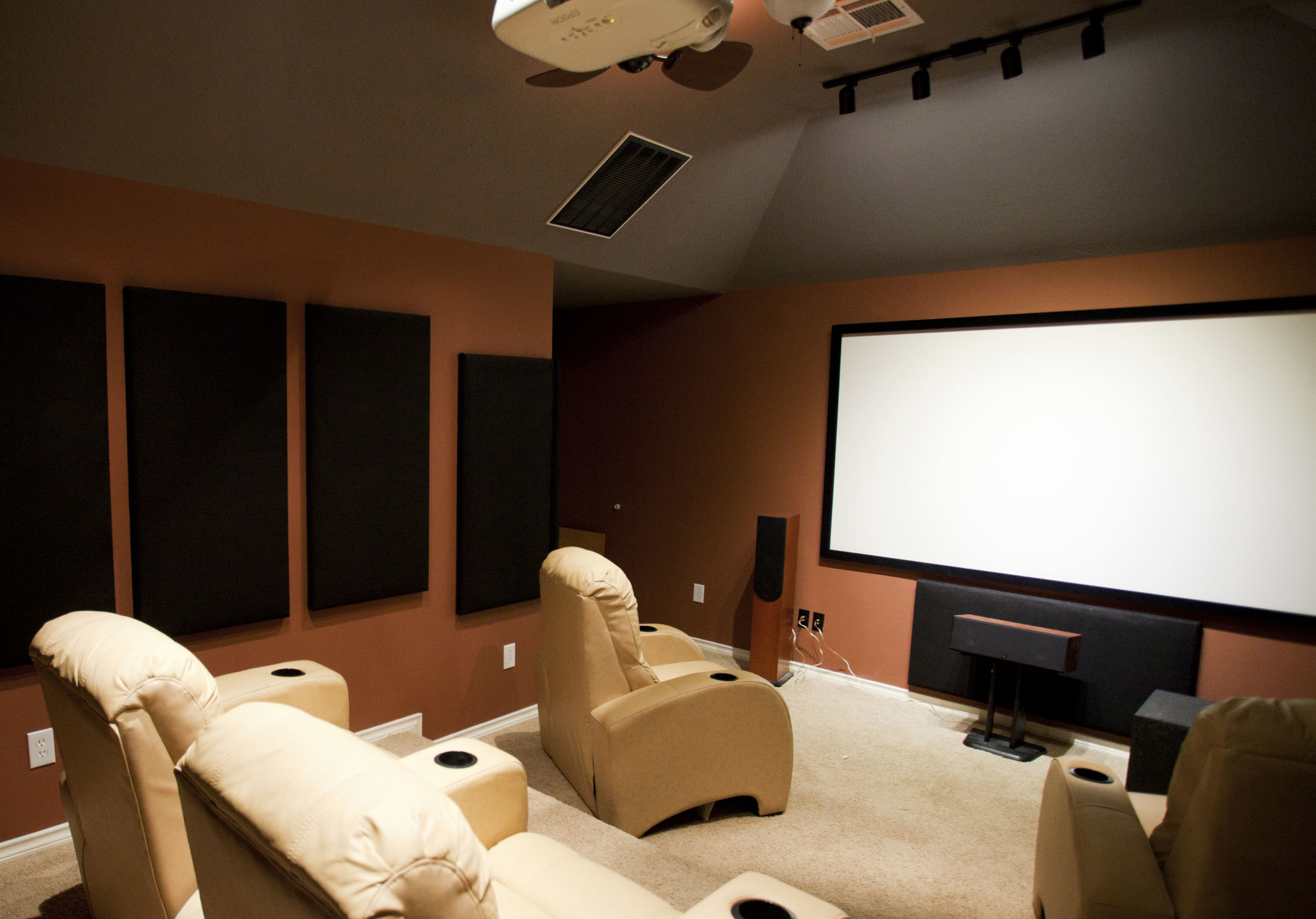
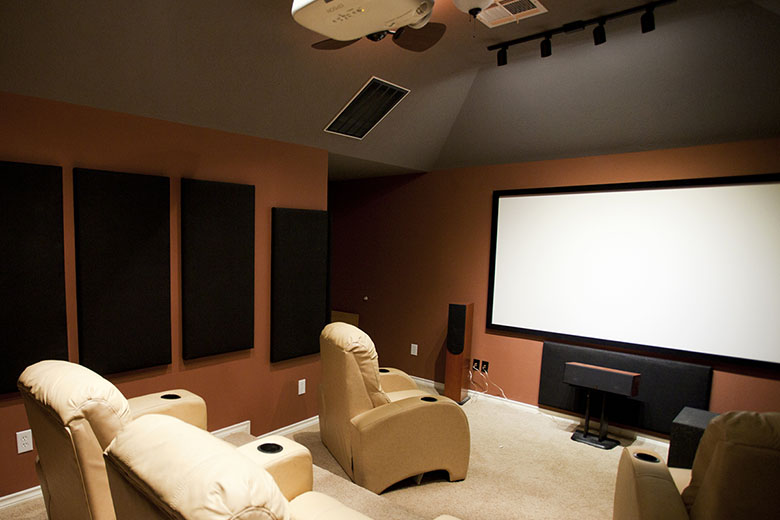
Did Brad Pitt's head get really wrinkly or is that just your crown molding? If you have a projector but no projector screen, you're getting subpar picture quality and are wasting a great machine. Even if your wall is a crisp, spotless white, any imperfections will be obvious. But do you get wall-mounted screen or freestanding? Which size and aspect ratio? Manual or motorized? Don't worry - we've got you covered. Below are the best projector screens of this year, no matter your budget. For more background, see our projector screen comparison table and buying advice below the picks.
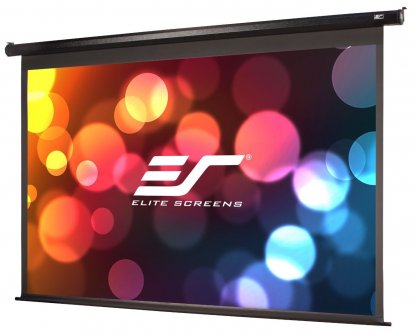 Size: 100”
Size: 100”
Aspect Ratio: 16:9
Gain: 1.1
What We Like: Elite quality with automation added.
What We Don’t: Perhaps a little too pricey for some people.
We think that right now, the best projector screen needs to be automated, easy to set up and use, and guarantee a particular level of picture quality. In our opinion, the Elite Screens VMAX 2 ticks all three boxes. For starters, not only do you get a very sizeable usable area, but you get a slightly increased aspect ratio, at 16:10. There is a full 180 degree viewing angle, and like many models in this range, it comes ready for both 4K and 3D viewing. Installation is dead simple, as it comes shipped fully assembled (so no electronics knowledge required) and you won't have to get up to adjust it, either, as it comes with its own remote. It's a clear choice over screens from Silver Ticket, its big competitor.
That said, we do think the price could stand to drop a little. The Elite Screens VMAX 2 comes in multiple sizes, like most screens here, but to be honest, it's still a little expensive for what it is. If you're looking for a less-expensive automated screen, we'd recommend the Spectrum Electric, also from Elite Screens.
See the Elite Screens VMAX 2
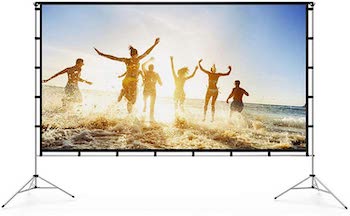 Size: 120”
Size: 120”
Aspect Ratio: 16:9
Gain: 1.1
What We Like: Simple to assemble, with a great picture for the price.
What We Don’t: Needs a very dark environment, easy to tip over.
Up until recently, we’ve recommended Silver Ticket as the go-to brand for affordable projector screens. They recently discontinued many of their products, and are no longer widely available. Fortunately, there are several other excellent options, and one of them is the Vamvo Outdoor Indoor screen. It’s basic and functional, but it has several key advantages to other screens from the likes of Mdebeddron. For starters, it’s exceptionally easy to put together, and we think the picture is comparable to some of the more expensive screens mentioned here, like the Elite Screens Spectrum 2.
However, despite the Vamvo Outdoor Indoor claiming that it can be used, well, both indoors and outdoors, the reality is a little more complex. Without a very dark environment, such as a basement with blackout curtains, there is a noticeable degradation and picture quality. And while the screen is easy to build (it will be up and running in minutes) it’s also easy to tip over. Fortunately, a few sturdy weights. This from happening, and we think the great picture quality is enough to mitigate these issues. Vamvo have big shoes to fill, but they’ve done well here. This is an ideal screen if you’re on a budget.
See the Vamvo Outdoor Indoor
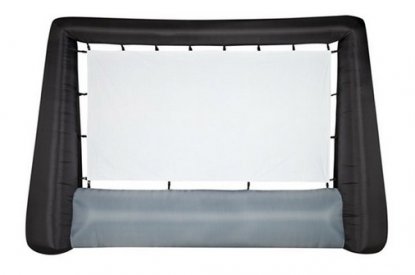 Size: 150”
Size: 150”
Aspect Ratio: Unavailable
Gain: Unavailable
What We Like: Innovative approach.
What We Don’t: No stats available.
Now here's something a bit different in an outdoor screen: this Giant Gemmy model inflates like a bouncy castle, so you won't need to mess around with pegs and guy ropes. It’s 151 inches wide and 85 inches tall, and even though the picture isn’t the sharpest on this list, you're still guaranteed lots of fun at the next barbeque. There’s nothing to stop you using it indoors, too - although it won't beat out similarly-priced models from Epson and Elite Screens on this count.
This screen includes a power adapter and self-inflates—no need to put your lungs to the test—and comes with a large carrying case to help cart it around. The Giant Gemmy is perfect for an outdoor movie night or sporting event with a crowd of people, but keep in mind that picture quality can’t be expected to match an indoor screen. We should say from the get go that tracking down stats, like again and aspect ratio, is surprisingly difficult for the screen. As we mentioned, go in prepared to deal with a surface that might not be ideal for your projector. All the same, this fulfills a very particular niche.
See the Giant Gemmy Airblown
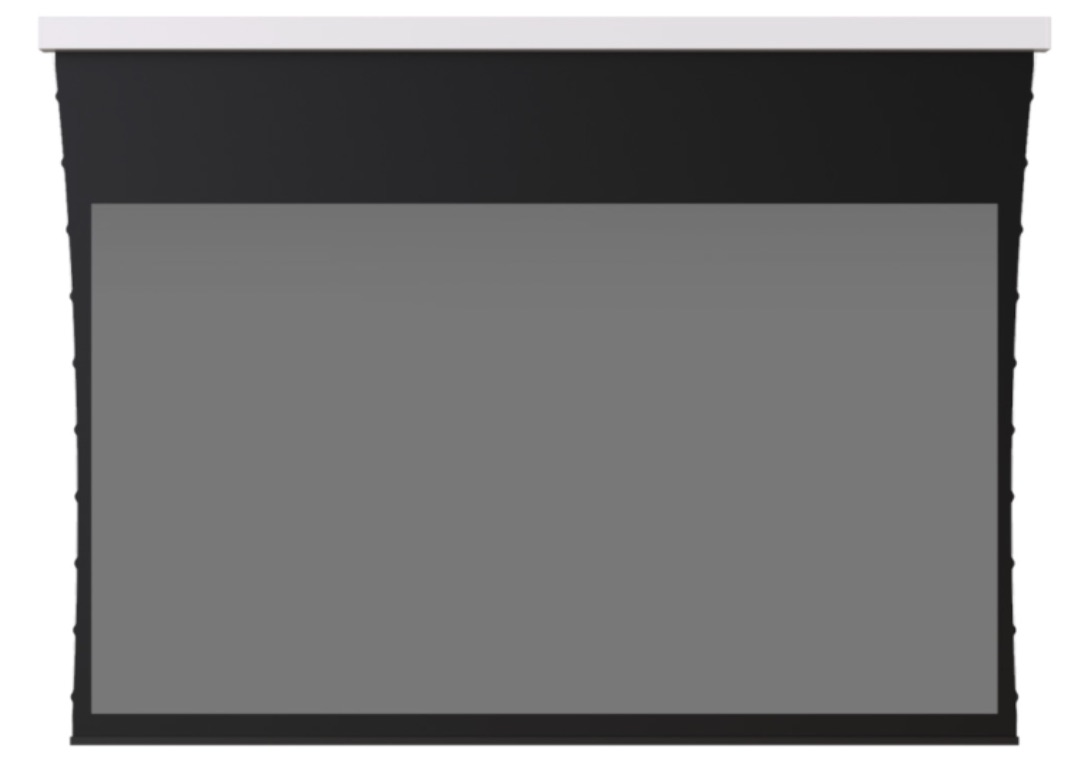 Size: 100"
Size: 100"
Aspect Ratio: 16:9
Gain: 1.2
What We Like: Huge range of size options and superb quality.
What We Don't: Hugely expensive.
Screen Innovations lives up to their name. For the third version of the Solo Pro screen, they kept what made the previous models successful – the sleek picture and excellent, eye-catching design – while adding in some fresh ideas. There’s now a huge range of size options, all the way up to 200” (we’ve highlighted the 100” version here). The motors are rechargeable, meaning you no longer need to connect this motorized screen to a wall outlet. Perhaps the best improvement of all is that the screen can now be mounted in reverse orientation, which means it can be hung directly above an existing picture or TV screen. The Solo Pro 2 is also one of the easiest screens on this list to install.
The big downside of the Solo Pro 3 Indoor is the price. While you may find different prices if you shop around, they probably won’t be all that different, making the Screen Innovations Solo Pro 3 the most expensive screen on this list. That said, if it is going to the centerpiece of your home theater or great room, you can't beat the quality or design.
See the Screen Innovations Solo Pro 3 Indoor
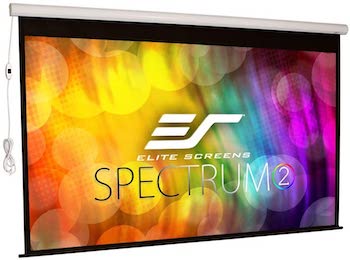 Size: 100”
Size: 100”
Aspect Ratio: 16:9
Gain: 1.1
What We Like: Tubular motor is whisper-quiet, fast, and smooth.
What We Don’t: Currently a little overpriced.
Any manufacturer can attach a motor to a screen, but only a few can do it really well. Elite Screens Make the best on the market, in our opinion, and their Spectrum 2 proves it. The screen uses a tubular motor, which is much quieter, faster, and smoother than the synchronous motors found in screens like Elite’s VMAX 2. The inclusion of the new MaxWhite FG material not only stiffens this non-tensioned screen, but also enhances the picture. We don’t think it beats the VMAX 2 or other motorised screens like the Screen Innovations Solo Pro 2 for quality, but it more than holds its own.
The biggest downside is the price. The Elite Screens Spectrum 2 is almost a hundred dollars more expensive than the original, and that may raise a few eyebrows. However, if you’re prepared to spend the money, you’ll get what is commonly considered to be one of the best motorised screens around. Elite have really made this particular category their own, and the Spectrum 2 is an exemplary screen.
See the Elite Screens Spectrum 2
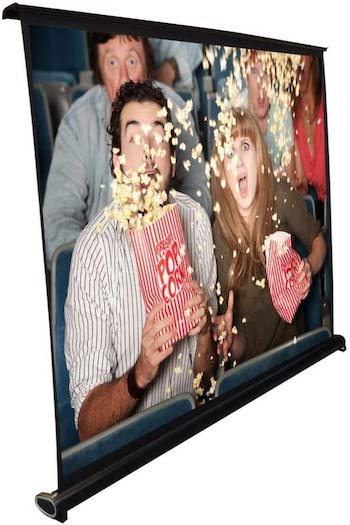 Size: 40”
Size: 40”
Aspect Ratio: 4:3
Gain: Unavailable
What We Like: Bright image matched with great portability.
What We Don’t: Flimsy design, requires careful setup.
Portable projector screens can be hit or miss, but the Pyle PRJTP46 is definitely a hit. Its small size (40 inches) and light weight make it easy to take with you, and it sets up in moments. It’s the ideal screen for impromptu movie nights at a friend’s house, or quick presentations while at work. The image is bright and clean and although pricier screens like the Vamvo Indoor Outdoor have the Pyle beaten on clarity, the quality is still good for the price.
One thing to be aware of with the Pyle PRJTP46 is that the design isn’t as robust as we’d like. The portable nature means that it’s somewhat flimsy, and can be knocked over or out of true if you brush against it. The viewing surface also has a tendency to not be completely flat, with more than one wrinkle popping up when we tried it. If you demand absolute clarity, and a totally flat viewing surface, it maybe worth looking at a more permanent option like the aforementioned Silver Ticket, or a model from Elite Screens.
See the Pyle PRJTP46
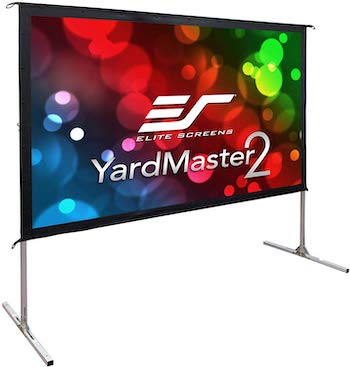 Size: 120"
Size: 120"
Aspect Ratio: 16:9
Gain: 1.1
What We Like: Excellent picture for an outdoor screen.
What We Don't: A little unforgiving.
If you’re looking for a screen that can pull double duty as both an indoor and outdoor system, then it’s worth checking out the Elite Screens Yard Master 2. We think it’s the best ‘double duty’ screen on this list, with a better picture than the cheaper JaeilPLM 100 Inch 2-in-1. The robust construction and high quality materials make the Yard Master 2 a good pick and, as a bonus, it’s exceptionally easy to set up. It comes in a variety of sizes, all the way up to 180”. We’ve flagged the 120” version here, which should be more than enough for most people – the availability of larger versions varies depending on the store.
One thing to note with this model is that it may take a little time and experimentation to get the best picture quality from it. The Elite Screens Yard Master 2 is an excellent screen, but it felt a bit unforgiving. As such, it may be worth sacrificing picture quality for ease-of-use if you are new to home projection. Regardless, this screen definitely belongs on this list.
See the Elite Screens Yard Master 2
 Size: 135”
Size: 135”
Aspect Ratio: 16:9
Gain: 0.95
What We Like: Unbelievable picture.
What We Don’t: Very expensive for what you get.
Stewart make some of the most expensive screens available, so it’s a good thing the image quality matches the price. The Cima 135” isn’t quite as mind-blowing as the Phantom HALR, but it’s very good, with a big viewing area matched by some excellent picture quality. It’s relatively easy to set up and use, and we think that were it not for the eye-melting price tag, it would probably snag a spot on the regular list.
They use their own material, Tiburon G2, which has been tuned and calibrated to provide optimal viewing conditions at almost all angles. It rejects 40% of ambient light, and although it doesn’t really handle 3D, the smooth, durable, grey surface provides stunning quality, provided you’ve got a decent projector to match it. This screen and its variants are definitely not for everyone, but you do get what you pay for, and this is an absolute monster of a product. Check it out, if you have the funds.
See the Stewart Filmscreen Cima 135"
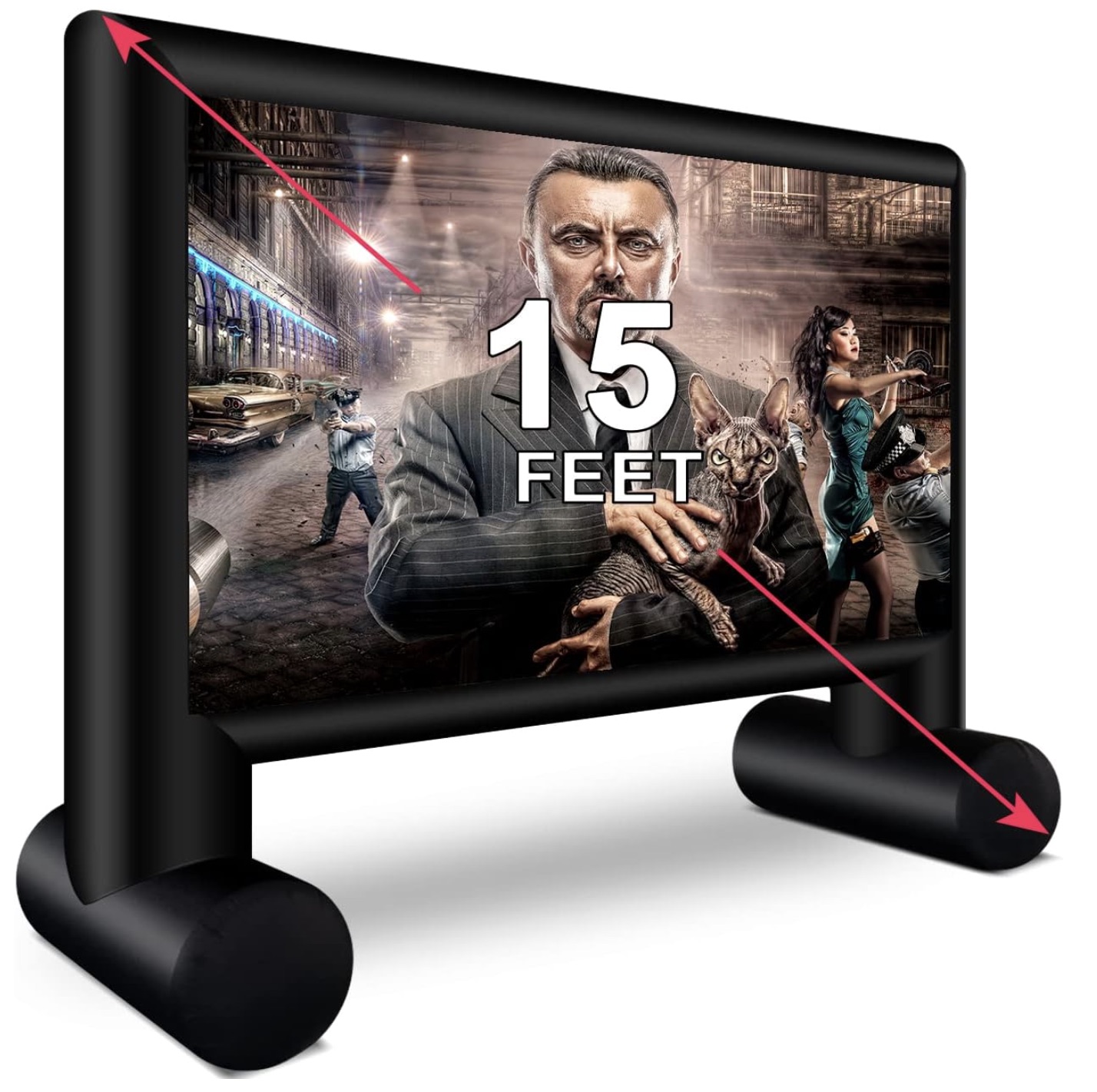 Size: 180”
Size: 180”
Aspect Ratio: 16:9
Gain: Unavailable
What We Like: Massive size, easy to set up and use.
What We Don’t: Tough competition at this price point.
Inflatable outdoor projector screens tend to be massive— it’s sort of the point— and the SUNCOO Inflatable Movie Screen is no exception. It’s a gigantic 120 inches wide, with 12.5 square feet of viewing area. Inflating it is relatively simple (the package includes a motorised pump) and although it doesn’t match the clarity and sharpness of indoor screens, it’s a perfectly acceptable option for hosting an impromptu outdoor movie night.
The problem is that there are better options available. The Giant Gemmy Airblown is still the leader in this particular category. Although it’s more expensive, by about $30, it’s also larger, and even easier to set up than the SUNCOO. The world of inflatable projector screens is a crowded one, and although the SUNCOO is a viable alternative to the Gemmy, it lacks any killer features to elevate it to a true essential. If you want an even larger option, there is a 200 inch version available, although it is of course more expensive.
See the XHYCPY Inflatable Projector Screen
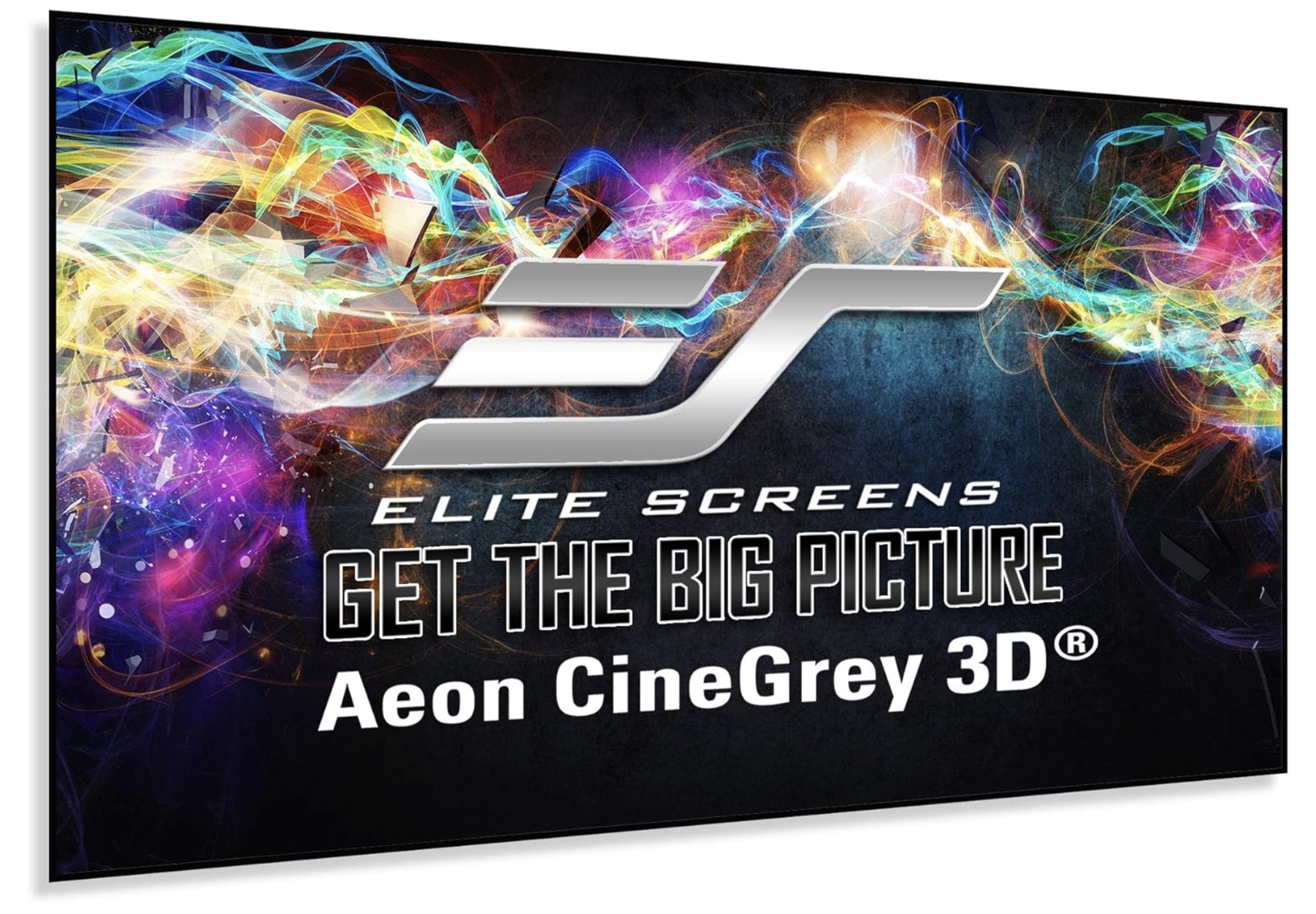 Size: 100"
Size: 100"
Aspect Ratio: 16:9
Gain: 0.6
What We Like: One of the better ultra-short-throw screens available.
What We Don’t: Requires a really good projector.
The Elite Screens Aeon 100” is a screen designed for ultra-short-throw projectors – as in, ones that are directly beneath the screen. This model is one of the better ultra-short-throw (UST) screens available, despite not being quite as assured as the Screen Innovations competitors, and costs a fraction of the price. It offers outstanding picture, especially in rooms which are not perfectly dark. Although the gray shade might not look great when it isn’t being used, it’s able to push back the majority of off-angle ambient light. That means that you can get away with just closing the curtains without having to worry about stray ambient lighting sneaking in.
However, to get this effect, you will require a really good projector, which can easily double the total setup cost. Other similarly-priced screens are a little more forgiving with low quality projectors. However, we still think that the Elite Screens Aeon is a solid choice, especially if you have a room that isn’t ideal for projection, and we can't help but love the price.
See the Elite Screens Aeon 100”
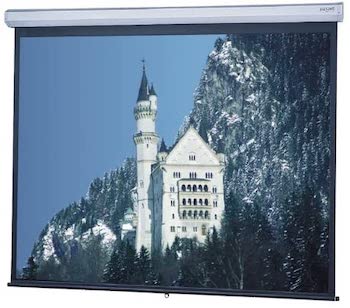 Size: 130”
Size: 130”
Aspect Ratio: 16:10
Gain: 1.1
What We Like: Solid picture, one of the best rollers we’ve seen.
What We Don’t: You’ll need to pay extra for advanced features like Controlled Screen Return.
Da-Lite are an odd company. They’ve been around since 1909, and they make some exceptional screens (such as the one we featured here, the 130” Model C) but they have next to no online presence. That’s peculiar, but it doesn’t stop the Model C being a worthy alternative to models like the Elite Screens VMAX2. The picture is solid, and we think that the roller used by Da-Lite is one of the best we’ve tested, with an impeccably smooth action.
One big downside with the Da-Lite Model C is that it doesn’t offer any advanced features for the money. Da-Lite Have a feature called Controlled Screen Return, which allows you to roll up the screen without jerking or damaging the mechanism, but you’ll have to pay an extra few hundred dollars to get it, which we think is kind of outrageous at this price. If picture quality is what matters to you, then the Model C is worth considering. But other screens like the previously mentioned VMAX 2 offer a better overall package.
See the Da-Lite Model C
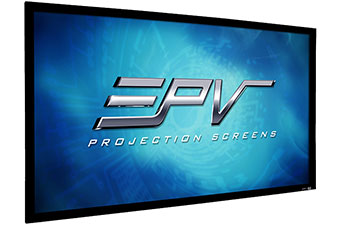 Size: 125"
Size: 125"
Aspect Ratio: 2.35:1
Gain: 1.3
What We Like: Backlight, edge-free design.
What We Don't: Far too expensive for most people.
EPV made one of our previous favorite screens, the DarkStar eFinity, and the Polar Star is a significant improvement. It has a unique edge-to-edge design, which means that while there is still a very slightly smaller viewing area than the overall size, it's kept to an absolute minimum. The screen also ships with a backlight, helping to further enhance the already fantastic picture and color. It also helps that it's fully ready for 3D and 4K, and that installation is a cinch.
But is it really going to beat the Seymour Screen Excellence Ambient-Visionaire Black 1.2, which is available for nearly $1,000 less at the time of writing? Our opinion is, it isn't. It's just a little too expensive right now, and we think the Seymour is a better option for most people. This high-end screen is still fantastic, but it should only be bought by those with a little bit of cash to burn. All those who are seduced by that amazing name…
See the EPV Polar Star eFinity
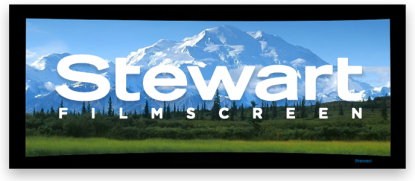 Size: 110”
Size: 110”
Aspect Ratio: 16:9
Gain: 1.0
What We Like: Innovative tech, hugely accurate.
What We Don’t: Some artifact issues, extremely pricey.
Would you pay over $4,000 for a screen? It seems like a joke, until you read about what Stewart have done to make the Phantom HALR 110” screen among the best on the market. The secret is down to their ambient-light-rejecting technology, which really sets the screen apart. Without getting too technical, it involves the application of multiple layers to the screen body: a highly reflective under-layer, with a light diffusing layer plastered on top. What that means is that any light that isn’t directly projected onto it simply won’t exist.
Or at least, that’s the theory. For while this is an absolutely fantastic screen that delivers some genuinely brilliant picture quality, it does have its issues. Chief among these is its inability to deal with fast pans where the footage is bright – something which leaves behind visible artefacts. It’s enough to knock it down the list a little bit, a fact not helped along by that staggering price tag. Ultimately, this is a great screen with a lot of potential, but it isn’t quite there yet.
See the Stewart Filmscreen Phantom HALR
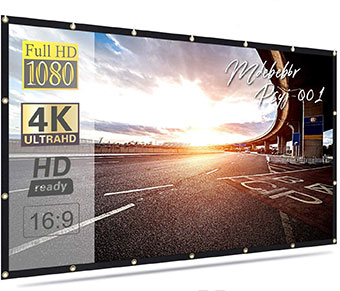 Size: 120”
Size: 120”
Aspect Ratio: 16:9
Gain: Unavailable
What We Like: Super-affordable price, good picture.
What We Don’t: Fold-up design means wrinkles if not carefully mounted.
Usually, we don’t recommend dropping this low in price for a projection screen as quality can plummet, but we will make an exception for the Mdbebbron 120-inch Projection Screen. No, we don’t know how to pronounce the name either, but there’s no question that the screen has a unique proposition. It’s not rigid, but instead, is soft and flexible, and even ships folded up like a sheet. That means it’s one of the simplest and cheapest ways to get home projection. For example, it’s much easier to manage than the Best Choice Products Manual Projector Screen, which is over double the price.
However, the fold up design of the Mdbebbron comes with some major disadvantages. Unless it’s carefully mounted, you’ll have wrinkles for days, which is not going to do your picture any favors. The mounting solutions that ship with the screen are poor, at best, so it means you’ll need to do a bit of DIY. If you can get past this, however, you’ll find that this affordable screen is an interesting choice for those on a tight budget.
See the Mdbebbron 120 inch Projection Screen
| Screen | Price | Size | A.Ratio* | Gain | UA** | Aut.*** | VA**** |
|---|---|---|---|---|---|---|---|
| Elite Screens VMAX 2 | $665 | 100" | 16:9 | 1.1 | Unavailable | Yes | 180° |
| Vamvo Outdoor Indoor | $120 | 120" | 16:9 | 1.1 | 118" x 49" | No | 160° |
| Giant Gemmy Airblown | $164 | 150" | Unavailable | Unavailable | 123" x 70" | No | 160° |
| SI Solo Pro 3 | $5,043 | 100" | 16:9 | 1.2 | 53.9" x 95.9" | Yes | Unavailable |
| Elite Screens Spectrum 2 | $345 | 100" | 16:9 | 1.1 | 87" x 49" | Yes | 180° |
| Pyle PRJTP46 | $39 | 40" | 4:3 | Unavailable | 32" x 24" | No | Unavailable |
| Elite Screens Yard Master 2 | $185 | 120" | 16:9 | 1.1 | 104" x 59" | No | Unavailable |
| Steward Cima 135" | $1,926 | 135" | 16:9 | 0.95 | 123"x 71" | No | 120° |
| XHYCPY Inflatable | $100 | 180" | 16:9 | Unavailable | No | Unavailable | |
| Elite Screens Aeon 100” | $660 | 100" | 16:9 | 0.6 | 87.2" x 49" | No | Unavailable |
| Da-Lite Model C | $937 | 130" | 16:10 | 1.1 | 116" x 65" | No | Unavailable |
| EPV Polar Star eFinity | $3,180 | 125" | 2.35:1 | 1.3 | 115.2" x 49" | No | 120° |
| Stewart Phantom HALR | $4,132 | 110" | 16:9 | 1.0 | Unavailable | No | 120° |
| Mdbebbron 120 inch | $27 | 120" | 16:9 | Unavailable | 104" x 58" | No | Unavailable |
*A.Ratio = Aspect Ration
**UA = Usable Area
***Aut. = Automation
****VA = Viewing Angles
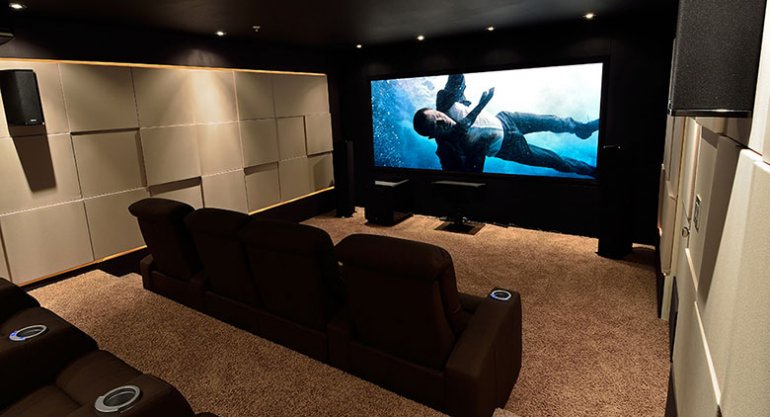
The most common question we get sent regarding projector screens is very simple: why can’t I just use the big, white wall that is already in my living room? To answer that question, and explain why it’s a really bad idea, you have to understand how light reacts on certain materials. When you project a movie, what your projector is doing is shining light onto the projection surface. No more, no less. For you to be able to get a high quality image, as much of that light as possible needs to be reflected back at you, so it can enter your eyes. So far so good.
The problem is, walls – even ones painted white – aren’t built to be reflective. There’s a very good reason for that, in that living in an apartment or a house with reflective walls would be pretty unpleasant. More importantly, walls aren’t completely smooth: even the best ones have a slight texture, one which is random – if you look close enough – and will do horrible things to light when it’s reflected onto it. That’s irrespective of how bright white the paint is. Yes, you could still in theory project an image onto it, but it will be nowhere near as good as it would be if you used a dedicated screen. That’s not only due to the fact that screen material is designed to accurately reflect the light from your projector back, while rejecting as much ambient light as possible, but also because most if not all projection screens come with a black border. There’s a reason for this: it’s a psychological trick, separating the image on the screen from the world around it in our mind, and making the image clearer. And no, painting a black square or rectangle on the wall will not give you the same effect. Put that paintbrush down.
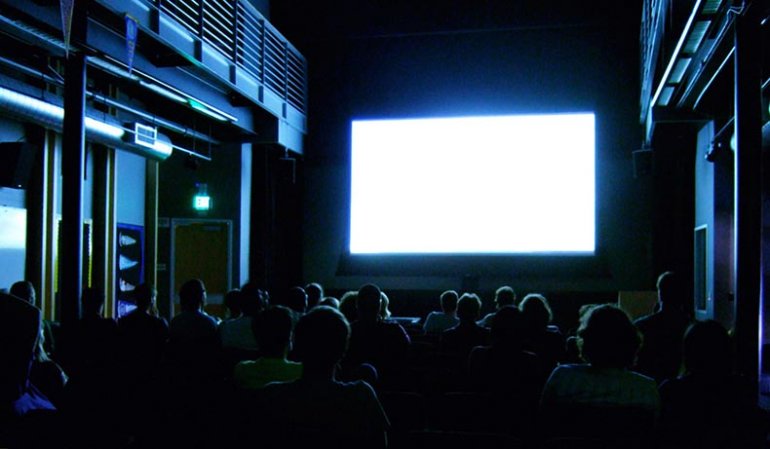
Each screen will come with full instructions. If not, have a quiet word with the manufacturer, and tell them to stop being ridiculous. Many screens are free-standing. Some can be inflated, which is often the easiest option. Others will need to be bolted to the wall, which will require the use of a screwdriver and a cable detector. Please use a cable detector. Don’t go drilling into walls that may hide an electric shock.
If you’re setting up a theater room, you’ll have seats spread across a wide area and you’ll want to get the same picture everywhere. If you’re getting a screen for a theater room, you may want to dip below 1.0 screen gain - gain is explained below). Some grey screens claim a 0.8 measurement, which would help in wider rooms. However, if you’re setting up a conference room, or putting a projector in your living room, getting a higher-gain screen means you’ll be able to project with some lights on or when the sun is out. In general, a high gain is more helpful in a wider range of environments while a low gain is better at accurate color recreation and producing wide viewing angles. If this is super important to you, and all you want is a screen that is easy to set up, then we strongly recommend the Elite Screens VMAX 2, which balances terrific picture quality with very simple setup.
Very obviously, when you’re working with projector screens, you need to be concerned about size. This is not just a simple as two measurements of height and width. For starters, actually getting those figures involves a (sometimes reasonably deep) dive into manufacturer specifications. This is because manufacturers give the size of the screen in a single measurement, which represents a line from one corner to the other, diagonally. It makes for good marketing copy, but it can be a little bit annoying, as it doesn’t actually tell you how much of the screen is going to be taken up with an image.
Fortunately, one of the things many manufacturers do state is what is known as the usable area of the screen – as in, the actual area which can have an image projected onto it, usually contained within a simple border. And because we love you, we’ve dug this out for you. This will give you a general idea of just how big your movie image is likely to be. Remember: size isn’t everything, and you’ll get far more out of a slightly smaller screen made out of high quality material then you will out of a larger screen costs a little less.
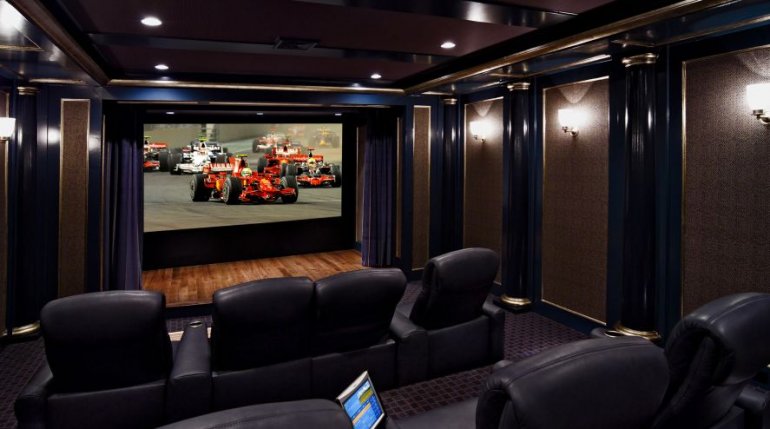
Aspect ratio refers to the shape of the projected image, measured in various sizes.16:9 and 4:3 are common, but there are various options. Although 16:9 has stormed standalone TVs, some movie aficionados prefer 2.35:1. However, the HD standard (and the upcoming Blu-ray Ultra High-Definition standard) are for 16:9. If all your media is 16:9, you’ll want to get a screen to match to maximize your screen real estate. Also consider that larger screen need more support, with many large screens coming in at 35 pounds or more.
Gain is a measurement of light reflected off the screen to the optimal viewing angle (the “Zero Degrees Viewing Axis”). A screen gain of 1.0 is equivalent to the light reflected off “a standard white (magnesium oxide) board,” according to Projector Central, who presumably know about these things. The easiest way to think about it is as a percentage. A screen with a gain of 1.0 reflects back 100% of the light shone on it. A screen with 0.6 will only reflect 60% back, and a screen with 1.2 gain will shine back light at a 120% brightness. (For reference, the screen on our list with the brightest gain is the Seymour Screen Excellence Ambient-Visionaire Black 1.2 - unsurprisingly, its gain is 1.2).
Now you might think that, taking all that into account, a screen with high gain is what you want to go for, right? Well, it’s not that simple. High gain screens have problems. For one thing, the higher screens gain, the lower the viewing angle is – we will talk about this in more detail below, but the upshot is that the higher the gain, the harder it is to see a clear image unless you’re sitting directly opposite the screen. If you have a large screening area with lots of seats, especially ones off to the sides, you may want to go for a screen with a slightly lower gain. You’ll need to reduce the ambient light, but you should be fine. If you have a small viewing area, or space to put all the seats directly in front of the projector, then by all means go for a high gain screen.
Imagine yourself sitting in front of a projector screen, watching Mad Max, or Harry Potter, or whatever your favorite movie may be. You are sitting perpendicular to the screen itself, facing it. You are able to see everything. Now, imagine a half-circle, with you at the circle’s apex and the screen directly opposite on the diameter. This – as anybody who has done high school math will know – is a shape of 180°.
If the screen's viewing angle is 180°, you will be able to see a clear image on it from anywhere in the half-circle. If it’s 120°, the image will start to blur and disintegrate as you move to the sides of the circle. The lower the number gets, the more you will need to be seated directly in front of the screen to get a clear picture. Really, that’s all there is to it. Viewing angle is a subject that can be filled with tons of jargon, if you delve into it, but all you need to know is that the wider the viewing angle, the better. And as we said in the previous section, high gain screens typically have slightly lower viewing angles, so do take that into account.
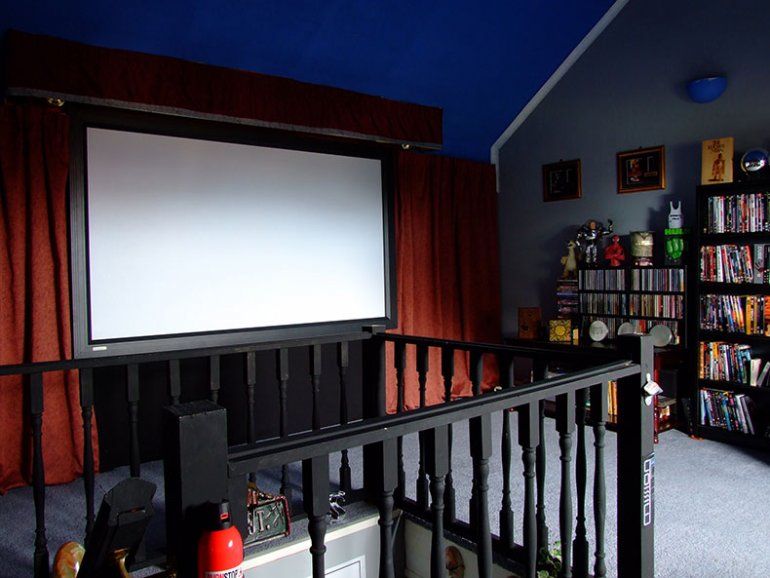
In a movie theater, the front speakers are nowhere to be seen. That’s because they are behind the actual movie screen itself. It’s one of those things that makes total sense when you think about it, but you also can’t believe you’ve never thought about it before. This arrangement can work because the material the screen is made out of is acoustically transparent – it doesn’t affect sound, allowing the soundwaves to pass through unmolested. We need the same arrangement in our home cinemas as well. This is especially true in small spaces, where you may need to place your floorstanding speakers or center channel speakers behind the actual screen itself. There’s nothing wrong with doing this, provided your screen’s material is acoustically transparent.
Ah, the beauties of modern technology. You want to get started on projection, but don’t want a boring projection screen hanging around your living room all the time? At the touch of a button, it could just roll away – although you will certainly pay for the privilege. Motorized or automated screens, which roll up into their housing, are typically a little more expensive than static screens, which don’t. You will also have to deal with potential breakages down the line, although it must be said that these are very frequent – especially not for the manufacturers on our list, most of whom make reliable screens. We think one of the best motorized screens, for reference, is the Elite Screens Spectrum 2, along with the VMAX2 mentioned above.
You may have bought a projector because it takes up less space than a TV, so you’d want a screen that hides away too. Or you might be decking out a media room and want a more permanent solution. Above we even suggest portable options that can be taken outside for backyard viewings. If you want something that can be hidden away, consider a ceiling-mounted screen. They can even be pulled down at the push of a button if you opt for a motorized version. However, if you’re setting up a Hollywood theater, get something a little more permanent — these screens are optimized to be perfectly flat and can be attached directly to your wall, mitigating any concerns about the screens getting damaged via wear-and tear.
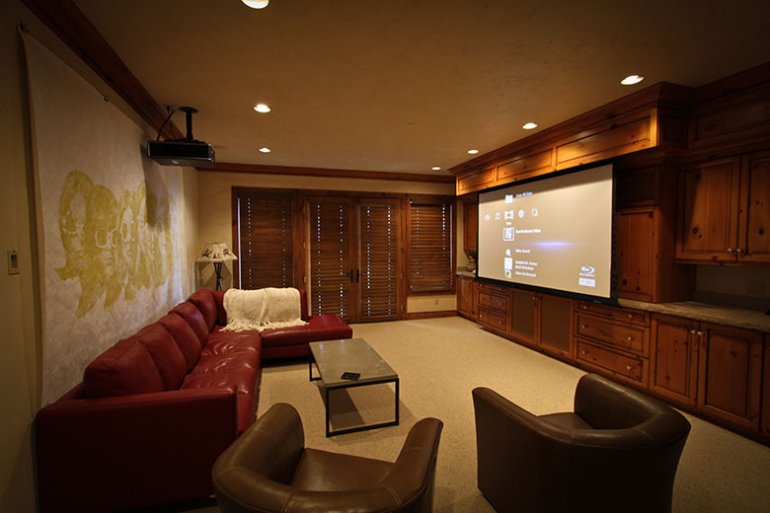
This is a particular stat that isn’t always immediately clear, but if you want to make projection of permanent part of your life, it’s super important to bear in mind. It refers to the ability of the screen to stay flat and even throughout its life. A tensioned screen will have sturdy wires running along the outside to keep the surface pulled taut, whereas a non-tensioned screen will not. A screen without tension will sometimes, over the course of its life, develop these weird little waves in it that can mess with the image. This isn’t a guarantee, but it’s sometimes prevalent, especially in cheaper screens. Not to worry, though. Most screens above around $200 will almost certainly have this feature included.
For the most part, projector screens and their setup instructions/buying advice have progressed to the point where actually purchasing and mounting one of these monsters is relatively straightforward. Unfortunately, this is a product category with a legacy of difficulty when it comes to actually getting the products themselves mounted, so it’s worth pointing out a couple of pitfalls that can easily be avoided.
The first, very obviously, is to make sure that your buying the right kind of projector, in terms of whether you want it manual or motorized. It’s an easy mistake to make, as you’re swallowed alive by aspect ratio and gain stats and viewing area sizes. You will also be wanting to closely measure the area you’re going to mount/display it, as it is super annoying to have to return a screen for a different size once you’ve actually bought it.
Second thing. We haven’t covered it here, as it’s not too big a problem with modern screens, but you need to make sure that the one you buy has a decent viewing angle. It’s not a problem if you just have a single couch, but if you have multiple sitting positions, you’ll want to make sure that your guests are going to be craning their heads or nudging their way into your space. Anything from around 90-180 degrees viewing angle should do the trick, and obviously the closer to 180, the better.
Finally: installation accessories. Some screens come with everything you need to mount them. But this is by no means guaranteed. You may need additional mounting brackets, screws, hammers, glue… Anything, really. Make sure you fully understand what is required to get a screen up and mounted, and if necessary, invest in things like mounting brackets.
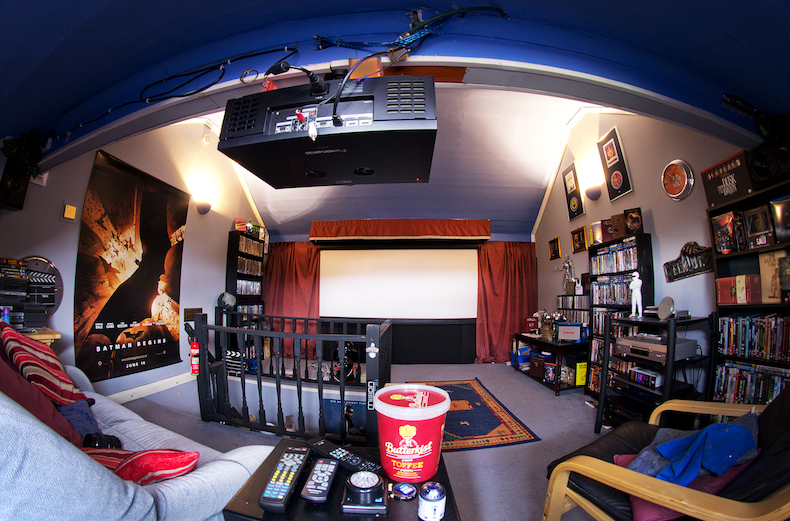
As the name implies, Ultra Short Throw projector screens are designed to take an image from a projector close to the screen. However, it's not as straightforward as you might think. Ultra Short Throw is one of the biggest R&D topics in projector screens right now, and there's a lot you need to consider when buying one.
The biggest issue with Ultra Short Throw (UST) screens has to do with their light rejection, especially with ambient light. These screens tend to spread their light off-axis, thanks to the short distances involved. Unfortunately, this spreads a lot of it out of the viewing sweet spot, making it more difficult to get a good picture. The solution to this problem is to invest in a screen specifically designed for UST projectors - the top one on our list is the Screen Innovations Solo Pro 2. Of course, you'll pay for the privilege - the Solo Pro 2 goes for $4,079 at the time of writing. However, despite the price, we believe it's worth it for the convenience and the extra sharpness UST projection provides.
Here’s the good news. If you decide to have a movie night in your backyard, setting up the screen is actually the easy part. There are several dedicated outdoor screens available, and several on our list – the best one right now is the Giant Gemmy Airblown. All you have to do, quite literally, is inflate it. As long as you pumped enough air into it, it will give you a competent, if slightly uninspiring, surface to project movies onto.
Most of the challenges that outdoor projection faces is with the projector itself. You want to have a projector that has at least 2,000 lumens of illumination and offers controls, like keystoning and lens shift, to help you get the right angle. Either way, once you have the projector setup, and you’ve chosen the right kind of screen, it’s very easy to sit in your backyard on a summer night, enjoying Netflix. We don’t have a list of the Best Bug Sprays, but you can probably handle that yourself.
Back To Our Projector Screen Picks Back To Our Comparison Table